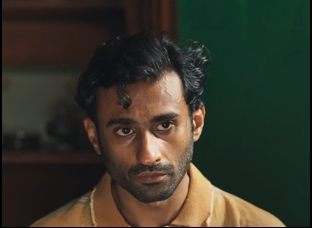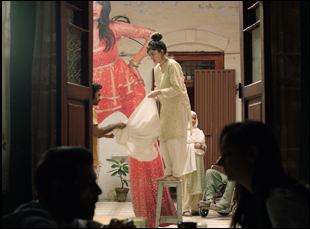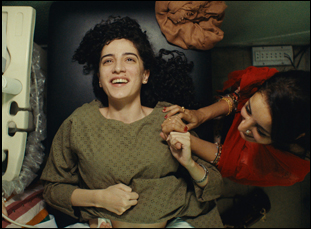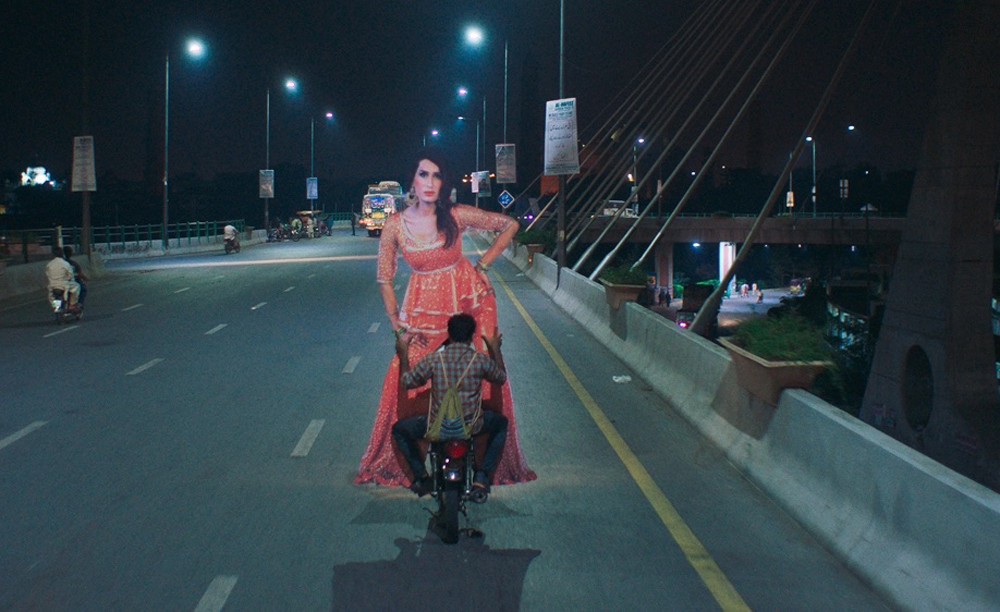A week before “Joyland” was set to be released in its native Pakistan, Saim Sadiq was looking forward to what was going to be a capstone for the internationally celebrated drama that sought to capture the soul of the place.
“Of course, the film releasing in Pakistan feels like a homecoming,” Sadiq said, just after the film played to appreciative crowds in Los Angeles at AFI Fest. “It is deeply special, perhaps the most special thing because just to put it to screen in the city that it was shot in and that I come from is like a moment of a lifetime for me.”
Things didn’t go as smoothly as one might hope in the days to follow when the local ratings board planned to prohibit “Joyland” from being screened, its executive producer Malala Yousafzai stepped in to lead a successful campaign to lift the ban and the film opened in much of Pakistan, though it has not been cleared yet to show in the Punjab province, namely its capitol of Lahore, which Sadiq and crew render so lovingly. It was a possibility that the director had to consider ever since the film’s triumphant premiere at Cannes where every interview was bound to include the question of whether his own professional breakthrough would be one for the entire nation when it confronts taboos regarding sexuality in the hardline Islamic stronghold so sensitively.
However, you can understand why Sadiq was confident that “Joyland” would overcome such resistance when the power of what he made simply can’t be denied, tenderly peering into the humble home of the Ranas where three generations of the family live under one roof and the camera drifts towards Haider (Ali Junejo), who spends his days looking after his brother’s kids with his idle time but is on the lookout for a more proper job. What that would be is in the eye of the beholder when there is work to be found just a few blocks away at a local theater where nothing too risqué happens, but it’s considered an adults only venue in the conservative culture where the exotic dance numbers are seen as too provocative, particularly when the club’s star attraction Biba (Alina Khan) is transgender. Haider’s father Abbas disapproves only knowing the name of the place, but his judgment appears just as questionable not only because of how harmless the job is or the pressing need for income, but the attention that Sadiq and co-writer Maggie Briggs pay to Haider’s wife Mumtaz (Rasta Farooq), who has put aside any professional ambitions of her own to help out around the house, discouraged from any outside work when her place is seen in the home as a woman.
Mumtaz admits she’s “a little jealous” when Haider has somewhere to head out to in the morning and curiously a little less so when he starts arriving home later and later at night as he develops a relationship with Biba and “Joyland” captures the yearning of all three to break free of the traditional roles that society would have them play, all wanting nothing more than to be accepted for who they are. If they feel overlooked, Sadiq and cinematographer Joe Saade are remarkably attuned to their characters’ desire, lavishing the central trio with deliberate and engrossing push-ins of the camera that consider how their emotions gradually simmer to the surface, and Junejo, Farooq and Khan all give iridescent performances where one can see their passion even when it can’t burn brightly. Truly representative of a country at a generational crossroads, “Joyland” was selected by Pakistan as its official entry to the 2023 Oscars and shortly before a wild two weeks for its director, Sadiq spoke about building on his evocative 2019 short “Darling,” which saw him first enter the dance theater in Lahore, to make the feature, how the physical landscape shaped the emotional terrain of the story and the gratifying sound of breaking glass.

The script for Joyland existed in some form before, but making the short informed me in a bunch of ways. Of course, the biggest takeaway was the working relationship that I had with Alina because in “Darling,” we didn’t get enough time nearly to work together, but I knew that she had a spark that could turn into something that’s amazing but that needed work. I had three years between the shooting of “Darling” to work with her and make her a part of the writing process. Even though Alina, as a human being, is very different from Biba — Alina is the sweetest, most agreeable human being and Biba is the opposite of that completely, a lot of people may assume that, because she’s a trans actress, she’s playing a version of herself, but that’s the furthest from truth.
At the same time, there were certain specificities in a lot of the lived experiences for Biba that for Alina could identify with, in terms of emotional violence or being aware of the [physical] violence around you, covering yourself from being vulnerable because there’s only a certain way that you can make it in this world. So she brought on board and during the writing process, I would call her and ask, “Okay, what would happen in this scene that I’m writing? Does this seem realistic enough? What would you think you would do?” That kind of exchange became a big cornerstone when I was shooting the film. I didn’t have to worry about the fact that, oh, I’m approaching Biba’s character from any place which might be dishonest. It felt very grounded and real because of her involvement.
[The short] also allowed me to explore the theater, and understand the nitty gritties, so when I came back to doing another draft of the feature, I was able to give more character to the theater as a space and more nuance and subtleties to the smaller characters [such as] the background boys who joined with Heather behind Biba as the big group of the dancers. That helped a lot.Is it true that you actually discovered Alina helping with the choreography for “Darling”?
She auditioned for the [“Darling”], because there’s no trans actors in Pakistan. We were looking to [the trans community] and seeing who was interested in being an actor, so she came as one of the people who auditioned, but she was just so sleepy and she wasn’t really interested at that point in time, so I was like, “No, this girl cannot act. It’s not working out.” But I knew that she’s a dancer, so we made a decision to go for another actor and then I wanted that actor to meet Alina, just to “look at the dance moves. Maybe she can help you pick up some nuances.” And when I went to do that, I met her in her house and she was more comfortable and more open and vulnerable and she wasn’t under the pressure of vying for a character, so I [thought], “Now she’s relaxed, she’s amazing and there’s so much to work with here.” I then had to switch [actors], which is a very unpleasant situation to be in as a director, but I think the other actor also completely understood, because for that particular character, it was Alina who fit the bill.
What sold you on Rasti and Ali, the other main actors?
Rasti actually came on board about a-month-and-a-half before the shoot because we had an actress [cast], an Indian actress and the political situation between Pakistan and India is always very tense, so it wasn’t really the best time to do it. Rasti was the first person actually, funnily enough, who read the script as a friend many years ago, and I had worked with her on a short film many, many years ago. When we knew that the other actress couldn’t do it, I reached out to Rasti and I was like, “You have to tell me right now.” I was really stressed because we were going to the shoot in a couple of weeks, but she came on board quite instantly because she was in love with the character.
Then for Haider, it was a very different process because we did a casting call for six months and auditioned more than 600 people. Most of them just weren’t right for the part, and the few who were remotely interesting, when they found out what the whole script was, they were not interested in doing this particular part because it’s very difficult role for a male actor to do because it’s not a showy part at all. He doesn’t have a lot of dialogue. He is not macho, so a lot of male actors already have a problem with that, and he doesn’t even have to have a big climactic showdown, even that’s given to another character, so he is a frustrating character, but I’m glad that Ali was the last person on our auditions list. He came in and I immediately knew that it was going to be him.
It’s a first film for all three of them, including Ali, but he’s a theater actor and was smart enough to look at the character as an opportunity, and he really worked his ass off for six months to make him real and believable and complex without taking any of the mystery away from the guy and to go to the dark places, yet keep the empathy alive. I’m so glad that eventually for all three of the parts, we found the right people.

For the longest time, the structure was that because I needed a character like Haider to go into these two very different spaces, one of which is his domestic household where he lives with his whole family and the other being this theater, which is a world of possibility, a far more sexual place and more fluid in nature. It’s also an open secret in a way — it’s a theater so people come, but nobody talks about it. The father has a big problem with the fact that he works at this theater and the people are the same who go into these spaces, but the way they project themselves and their morality just changes from one space to the other. So that helped me dig into the duality for that — all of these characters possess the dichotomy between what they want to be and what they think they should be for the society.
Of course, Joyland became a center, a Nirvana or a utopia in a certain way. This idea of all of these characters looking for a space where they can just shed their inhibitions for a while was something that was very fascinating to me because at the end of the day, what united all of these characters was their search for experiencing joy.
There is a really distinctive quality to the camerawork with these gentle push-ins that vary between handheld and smoother shots. Given how it would respond to the emotions of the scene, would some of those be determined on the day or was it all planned?
Joe Saade, our wonderful [cinematographer], and I had figured out certain rules which were actually based on the worlds that you were asking about. We were like, “Okay, we want to shoot the characters in this way based on the world,” like the outside world is shot more handheld and the inside world is shot far more on sticks, just to understand the stillness of that house and how things don’t move so much, and [how] the ideas and people have been existing in the same way that they existed a hundred years ago in that house. But outside it is a world of possibilities, so anything can come from anywhere. The camera and the movement had to evoke that emotion.
We stuck to the rules most of the time, but sometimes we would go and question the rules and be like, “Okay, we want to break the rule here because I think we thought that we want to shoot this on handheld, but this just has a feeling of its own and it’s sort of breaking our rule, but this feels correct for the moment based on what the actors are doing.” We would try to be cognizant of the fact [we were breaking the rule] and give a reason for why, so we could make that consistent going forward in the narrative. Because I think there’s a very specific feeling that changes depending on how you place the camera and how you move the camera, and even the speed of how you move the camera. If you’re pushing in, how slowly or how fast, and what pace are you pushing in that camera, it changes the feeling that you have as an audience, and for me and for Joe, that was always the cornerstone of our discussions. We would do it a certain way and it was always based on the feeling of what we wanted to achieve with a certain scene when we saw it.
Once you give this over to the actors, was there anything that may have happened that changed your ideas of what it could be?
A lot of things. My favorite moments from the film are the ones that I didn’t plan. For example, there’s a wonderful scene that I think is wonderful because it’s so well-acted between Biba and Haider when they’re talking and she offers him a drink and she leans in to get the drink, and in the script I had written that the glass should break, but I was told that if you’re doing a four-and-a-half-minute long take, we can’t break the glass because it’s a safety hazard. So I was like, “No, no, no, it’s fine. The glass doesn’t need to break.” We put a lot of carpets [down] to make sure that the glass doesn’t break and it didn’t break for the first six takes.
We were doing another take for other reasons and funnily enough, the glass broke even though there was so many layers and layers of carpets, and the actors continued the scene and let it be. Somehow the breaking of that glass happening organically just gave them this tension in the room that they worked with the rest of the take, and it’s the only take that I have where that happened. There’s this sexual tension in that scene, which is remarkable because they’re actually surprised that the glass broke and then he suddenly got up and started picking up the shards of the glasses and being careful with it, and she’s like, “Oh, be careful,” and he’s trying to push her back, so it’s all real. It wasn’t written in that way because it’s actually happening and that connection that suddenly developed in that scene was so palatable and beautiful, it’s just one of the many examples where the actors were smart enough to own a happy accident and just continue the scene because it suddenly made it all the more real.

For the production crew who were on set, it was primarily people from Pakistan. Joe Saade, the cinematographer, was the only person who was not from Pakistan, but from Lebanon and I wanted to make sure of that because I felt you need people who are closer to the space and to the specificity and the nuances of that particular space. Even though I believe, emotionally speaking, the film could be set elsewhere, but I was particular about the specificities of the city and the dialects, so it helps to have a lot of people, except for the DP, who were actually from Pakistan. At the same time, Jasmin [Tenucci, my editor] comes from Brazil and it was a great collaboration because that’s not the eastern part of the world necessarily, but looking at this as a story from another part of the world, but still relating to it and knowing how to craft it, that’s what I needed. So it was great to have the most suited person in the world rather than the person who perhaps knows the society or the specificity of that world the best.
Now a lot of our producers are from America, and it was funny to see, because our team in America, our editor from Brazil, and the crew from Pakistan and Joe, everybody got along so instantly because we all believed in the film in the same way and we had all wanted to make the same film that we had set out to make and we actually made it. The idea that we are different people from different places wasn’t so prevalent because we were so joined together by a story that we just looked at each other as a lot of people.
What’s it been like to see it resonate around the world?
It is very, very exciting. We finished the shoot this time last year — on the 19th of November 2021, so it’s a quick turnaround, and many people worked on this film so hard. But one has to acknowledge a little bit that this film is blessed in a certain way where it’s charting its own path and we are just bystanders now. Since May, [we’ve been] just watching the film do its own thing and create a space for itself in the world, which we could have perhaps not even thought of in our wildest dreams. Watching people be moved at screenings and responding so emotionally to the film and to these characters is very, very heartwarming and honesty a total surprise. I never thought about what the audience reaction would be. I just wanted to make the film that I wanted to make.
“Joyland” opens on April 7th in New York at Film Forum, April 14th in Pleasantville, NY at the Jacob Burns Film Center and expands on April 21st to Los Angeles at the Nuart Theatre, Montreal at the Cinema Du Parc and the Cinema Du Musee, Seattle at the SIFF Cinema Uptown and Toronto at the TIFF Bell Lightbox. A full list of theaters and dates is here.




